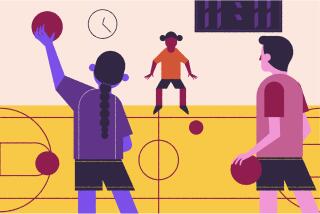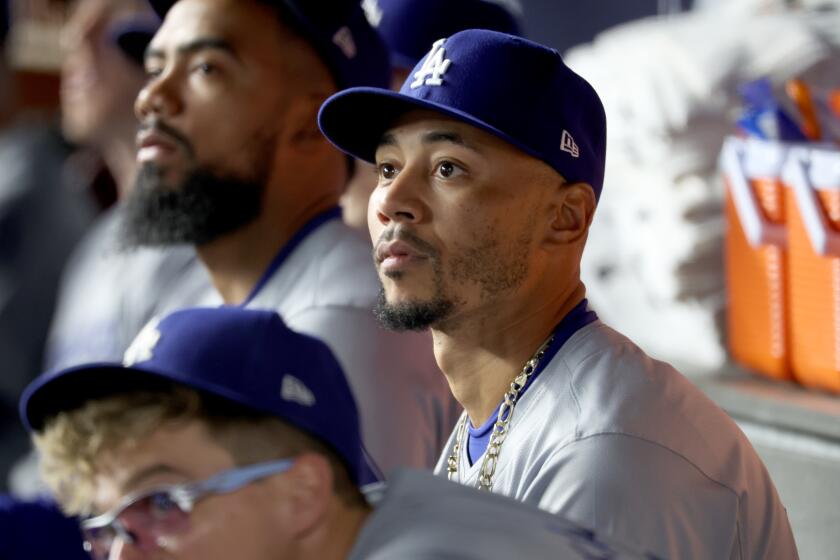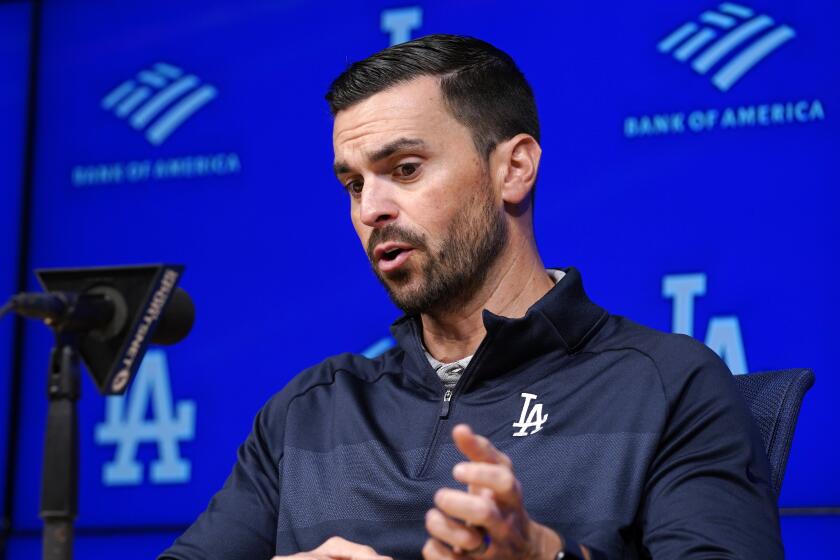In a League of Their Own : Disabled: A Glendale man starts a team that is a summertime hit with children who otherwise could not play baseball.
Adam Gaw, a dedicated Little League player, cannot plant his two feet firmly beside home plate. He was born with a crippling spinal defect and needs a wheelchair to get around. Yet his limitations didn’t keep him out of the batter’s box on a recent Saturday morning in Eagle Rock.
His grandfather rolled Adam’s chair into a comfortable position just to the left of the plate and locked the wheels. Because of his disability, Adam, 6, could not put his full body weight behind his swing. But he was determined to get on base.
Gripping a plastic bat with both hands, he whacked the ball smoothly up the middle, just past the pitcher’s mound. His grandfather released the brakes on his chair, and as Adam began rolling himself toward first to the cheers of onlookers, he broke into a wide grin.
Until recently, Adam could enjoy baseball only as a spectator. But an innovative new Little League program has finally given him his turn at bat.
“It’s the best thing that’s come along in Adam’s life,” said Leon Ames, the boy’s grandfather. “In the neighborhood, he sees other children playing baseball. He’s wanted to play, but they don’t have time for him.”
Adam is one of the 26 youngsters with mental and physical disabilities who have donned kid-size Dodgers uniforms and learned to savor that joyous instant when bat meets ball.
Last Saturday, the children on the Challenger Division Little League team wound up their eight-week season at Yosemite Park. Many parents said they enjoyed it almost as much as the children.
“For me this was wonderful because it was something to do outside on a Saturday--for him and for me,” said Irma Meza of Hollywood, whose son Daniel Meza, 18, has cerebral palsy. “He’s with other similar children. And I’m with mothers who understand.”
The league was organized, however, by a 40-year-old Eagle Rock resident who does not have a handicapped child.
Dan Dryden, an assistant manager with the Southern California Rapid Transit District, said he was inspired to take action when he flipped on the television set in a Las Vegas hotel room last year and saw a news report about a Challenger team.
“I lay there on the bed with tears flowing down my cheeks,” he said recently. “I love working with children and I love baseball. When I saw this program designed for children and baseball, it had my name written all over it. When I watched the credits, I expected them to say: ‘Dan Dryden, this program was designed for you. Come on down!’ ”
When he returned home, Dryden contacted League officials, who sent him a letter of encouragement, some brochures and a videotape describing the Challenger program.
He telephoned schools and hospitals to find disabled youngsters who might be interested in the program. “They passed the word and helped me recruit players,” Dryden said. “Then the parents of those players helped me recruit other players.”
Each parent paid $35 in dues to Little League, which provided insurance coverage. Dryden put up $1,000 himself to cover uniform costs, then borrowed and bought playing equipment. He recruited his son Tommy, 6, who plays on a regular T-ball team, as assistant coach.
The Challenger program permits the bending of traditional baseball rules to accommodate the participants’ playing skills. Because of the wide range of disabilities on his team, Dryden lets his players hit off a batting tee, and he doesn’t call balls, strikes or outs. Each player swings until he or she hits the ball, then goes to first base. When the next person connects, each runner advances and eventually crosses home plate.
A few of the players would have preferred a more competitive program with winners and losers, but Dryden did not alter his rules.
“When I have a boy in a walker who hits the ball with all of his ability and it just goes a few feet and it takes him a minute to get down to first base, there’s no way in the world I’m going to call him ‘out,’ ” he said.
The Challenger players are divided into two squads. One group bats while the other is in the field. An inning ends when everyone has had one chance to hit. Each game lasts three innings.
The team follows two well-entrenched ballpark traditions: The players and their families sing “The Star-Spangled Banner” to start the game and join in a rousing rendition of “Take Me Out to the Ball Game” during the second-inning stretch.
Dryden works with each child, helping to improve batting, throwing and catching ability. “This is not a baby-sitting service,” he said. “It’s a program for children to have an opportunity to do something they never dreamed they could do.”
Team members’ parents appear to support Dryden’s approach.
“Dan is absolutely marvelous,” said Ann Hermsen of Silver Lake, whose daughter Rebecca, 11, has Down’s syndrome and a hearing loss. “He doesn’t coddle the kids. He gives lots of encouragement, but he insists that they play to the best of their ability. And he knows what that is. He helps them stretch a little more each time.”
Hermsen added, however, that Rebecca is sometimes more competitive than Dryden’s rules allow. “Last game she tried to steal second base, but they wouldn’t let her,” her mother recalled.
The Challenger parents say their children have made great strides, on the ball field and off.
Leeann Holmes of Burbank said her son Timmy, 5, who has cerebral palsy, surprised her on a recent morning before a game. “He came and woke me up wearing his full uniform,” she said. “He had never dressed himself before. He could never get his pants on.”
She added: “He dresses himself a lot now. Just in the past month, he’s made a lot of improvement.”
The relatively new program has become a hit with parents of disabled children nationwide.
Jim Ferguson, director of the Challenger program at Little League headquarters in Williamsport, Pa., said it was proposed by parents in New England who wanted their handicapped children to play baseball.
In 1989 Little League approved five pilot Challenger leagues involving 300 children. Now there are 566 Challenger leagues around the country, serving about 20,000 children with varying disabilities.
“It was developed to give every child in the community the opportunity to participate in the largest organized youth sports program in the world,” Ferguson said.
To reduce the risk of injury and help lead youngsters through the game, each Challenger player must have a “buddy” standing nearby throughout the game. Ideally, the buddy should be a mainstream Little League player, but in Dryden’s group the buddies are usually parents or siblings.
Several parents said this system has helped bring family members closer together.
Although the season has ended, Dryden said he is looking for other recreation programs that could keep the team together.
“It has been much more rewarding than I ever dreamed it could be,” he said. “I had no idea that these kids would come as far as they did, that they would have so much fun. I never thought I’d become so close to them. As soon as they come around third base and score, I want to hug every one--and I usually do.”
More to Read
Are you a true-blue fan?
Get our Dodgers Dugout newsletter for insights, news and much more.
You may occasionally receive promotional content from the Los Angeles Times.










